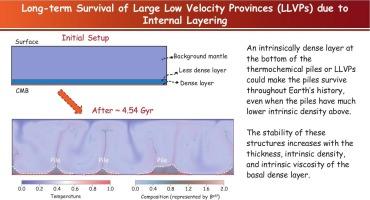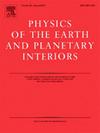由于内部分层,大型低速省(llvp)的长期生存
IF 1.9
3区 地球科学
Q2 GEOCHEMISTRY & GEOPHYSICS
引用次数: 0
摘要
地球最下端地幔中的大型低速道(Large low-velocity provinces, llvp)是地球深部地幔中最大的结构之一,其特征是地震波速度显著降低,其长期稳定性在地球热化学演化中起着至关重要的作用。llvp的稳定性在很大程度上受其相对于背景地幔的密度异常的控制。尽管llvp的密度异常仍然存在争议,但先前的研究表明它们可能具有更致密的基底层。在这项研究中,我们进行了地球动力学模拟,以研究这种基底致密层如何影响llvp的长期稳定性。我们发现,在类似llvp的热化学堆相对较轻并迅速混合到背景地幔的模型中,薄的、本质上密度更大的基底层的存在可以帮助这些堆在与地球历史相当的时间尺度上在核心-地幔边界(CMB)存活下来。我们的研究结果表明,在任何深度,llvp都不需要比周围地幔密度大,以保持长期稳定。相反,它们的密度可以分层,向CMB方向增加,有一个基本的致密层。本文章由计算机程序翻译,如有差异,请以英文原文为准。

Long-term survival of large low velocity provinces (LLVPs) due to internal layering
Large low-velocity provinces (LLVPs) in Earth's lowermost mantle, characterized by a significant reduction of seismic wave velocities, are among the largest structures in Earth's deep mantle, and their long-term stability plays a crucial role in Earth's thermal and chemical evolution. The stability of LLVPs is greatly controlled by their density anomaly with respect to the background mantle. Although the density anomaly of the LLVPs remains a matter of debate, previous studies suggested that they may have a denser basal layer. In this study, we perform geodynamic simulations to investigate how this basal dense layer affects the long-term stability of LLVPs. We find that in models where LLVP-like thermochemical piles are relatively light and rapidly mix into the background mantle, the presence of a thin, intrinsically denser basal layer can help these piles to survive at the core-mantle boundary (CMB) over timescales comparable to Earth's history. Our results suggest that LLVPs do not need to be denser than the surrounding mantle at all depths to maintain long-term stability. Instead, their density can be stratified, increasing toward the CMB, with a basal dense layer.
求助全文
通过发布文献求助,成功后即可免费获取论文全文。
去求助
来源期刊

Physics of the Earth and Planetary Interiors
地学天文-地球化学与地球物理
CiteScore
5.00
自引率
4.30%
发文量
78
审稿时长
18.5 weeks
期刊介绍:
Launched in 1968 to fill the need for an international journal in the field of planetary physics, geodesy and geophysics, Physics of the Earth and Planetary Interiors has now grown to become important reading matter for all geophysicists. It is the only journal to be entirely devoted to the physical and chemical processes of planetary interiors.
Original research papers, review articles, short communications and book reviews are all published on a regular basis; and from time to time special issues of the journal are devoted to the publication of the proceedings of symposia and congresses which the editors feel will be of particular interest to the reader.
 求助内容:
求助内容: 应助结果提醒方式:
应助结果提醒方式:


